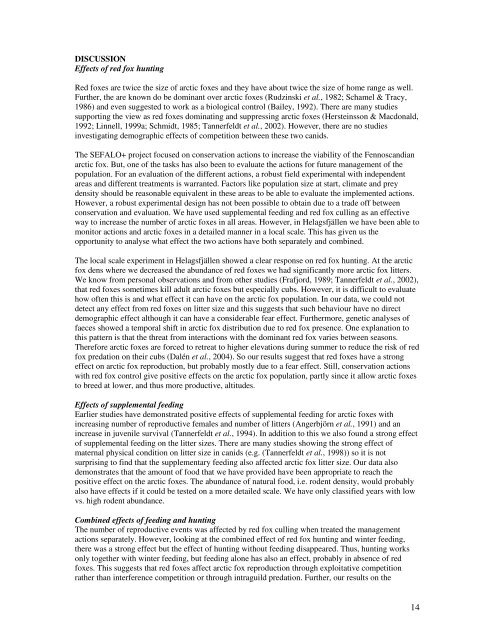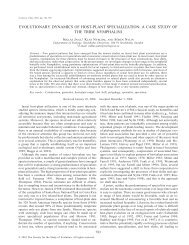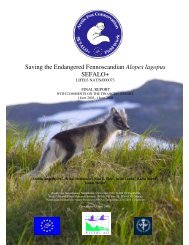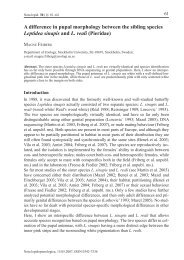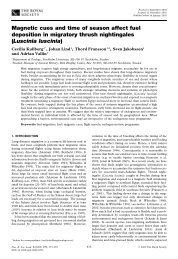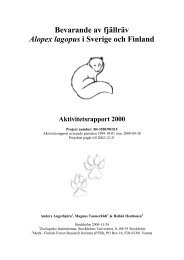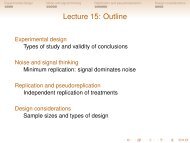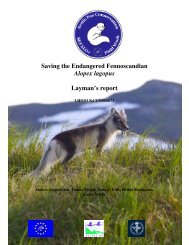The conservation of Fennoscandian arctic foxes - Stockholms ...
The conservation of Fennoscandian arctic foxes - Stockholms ...
The conservation of Fennoscandian arctic foxes - Stockholms ...
Create successful ePaper yourself
Turn your PDF publications into a flip-book with our unique Google optimized e-Paper software.
DISCUSSIONEffects <strong>of</strong> red fox huntingRed <strong>foxes</strong> are twice the size <strong>of</strong> <strong>arctic</strong> <strong>foxes</strong> and they have about twice the size <strong>of</strong> home range as well.Further, the are known do be dominant over <strong>arctic</strong> <strong>foxes</strong> (Rudzinski et al., 1982; Schamel & Tracy,1986) and even suggested to work as a biological control (Bailey, 1992). <strong>The</strong>re are many studiessupporting the view as red <strong>foxes</strong> dominating and suppressing <strong>arctic</strong> <strong>foxes</strong> (Hersteinsson & Macdonald,1992; Linnell, 1999a; Schmidt, 1985; Tannerfeldt et al., 2002). However, there are no studiesinvestigating demographic effects <strong>of</strong> competition between these two canids.<strong>The</strong> SEFALO+ project focused on <strong>conservation</strong> actions to increase the viability <strong>of</strong> the <strong>Fennoscandian</strong><strong>arctic</strong> fox. But, one <strong>of</strong> the tasks has also been to evaluate the actions for future management <strong>of</strong> thepopulation. For an evaluation <strong>of</strong> the different actions, a robust field experimental with independentareas and different treatments is warranted. Factors like population size at start, climate and preydensity should be reasonable equivalent in these areas to be able to evaluate the implemented actions.However, a robust experimental design has not been possible to obtain due to a trade <strong>of</strong>f between<strong>conservation</strong> and evaluation. We have used supplemental feeding and red fox culling as an effectiveway to increase the number <strong>of</strong> <strong>arctic</strong> <strong>foxes</strong> in all areas. However, in Helagsfjällen we have been able tomonitor actions and <strong>arctic</strong> <strong>foxes</strong> in a detailed manner in a local scale. This has given us theopportunity to analyse what effect the two actions have both separately and combined.<strong>The</strong> local scale experiment in Helagsfjällen showed a clear response on red fox hunting. At the <strong>arctic</strong>fox dens where we decreased the abundance <strong>of</strong> red <strong>foxes</strong> we had significantly more <strong>arctic</strong> fox litters.We know from personal observations and from other studies (Frafjord, 1989; Tannerfeldt et al., 2002),that red <strong>foxes</strong> sometimes kill adult <strong>arctic</strong> <strong>foxes</strong> but especially cubs. However, it is difficult to evaluatehow <strong>of</strong>ten this is and what effect it can have on the <strong>arctic</strong> fox population. In our data, we could notdetect any effect from red <strong>foxes</strong> on litter size and this suggests that such behaviour have no directdemographic effect although it can have a considerable fear effect. Furthermore, genetic analyses <strong>of</strong>faeces showed a temporal shift in <strong>arctic</strong> fox distribution due to red fox presence. One explanation tothis pattern is that the threat from interactions with the dominant red fox varies between seasons.<strong>The</strong>refore <strong>arctic</strong> <strong>foxes</strong> are forced to retreat to higher elevations during summer to reduce the risk <strong>of</strong> redfox predation on their cubs (Dalén et al., 2004). So our results suggest that red <strong>foxes</strong> have a strongeffect on <strong>arctic</strong> fox reproduction, but probably mostly due to a fear effect. Still, <strong>conservation</strong> actionswith red fox control give positive effects on the <strong>arctic</strong> fox population, partly since it allow <strong>arctic</strong> <strong>foxes</strong>to breed at lower, and thus more productive, altitudes.Effects <strong>of</strong> supplemental feedingEarlier studies have demonstrated positive effects <strong>of</strong> supplemental feeding for <strong>arctic</strong> <strong>foxes</strong> withincreasing number <strong>of</strong> reproductive females and number <strong>of</strong> litters (Angerbjörn et al., 1991) and anincrease in juvenile survival (Tannerfeldt et al., 1994). In addition to this we also found a strong effect<strong>of</strong> supplemental feeding on the litter sizes. <strong>The</strong>re are many studies showing the strong effect <strong>of</strong>maternal physical condition on litter size in canids (e.g. (Tannerfeldt et al., 1998)) so it is notsurprising to find that the supplementary feeding also affected <strong>arctic</strong> fox litter size. Our data alsodemonstrates that the amount <strong>of</strong> food that we have provided have been appropriate to reach thepositive effect on the <strong>arctic</strong> <strong>foxes</strong>. <strong>The</strong> abundance <strong>of</strong> natural food, i.e. rodent density, would probablyalso have effects if it could be tested on a more detailed scale. We have only classified years with lowvs. high rodent abundance.Combined effects <strong>of</strong> feeding and hunting<strong>The</strong> number <strong>of</strong> reproductive events was affected by red fox culling when treated the managementactions separately. However, looking at the combined effect <strong>of</strong> red fox hunting and winter feeding,there was a strong effect but the effect <strong>of</strong> hunting without feeding disappeared. Thus, hunting worksonly together with winter feeding, but feeding alone has also an effect, probably in absence <strong>of</strong> red<strong>foxes</strong>. This suggests that red <strong>foxes</strong> affect <strong>arctic</strong> fox reproduction through exploitative competitionrather than interference competition or through intraguild predation. Further, our results on the14


